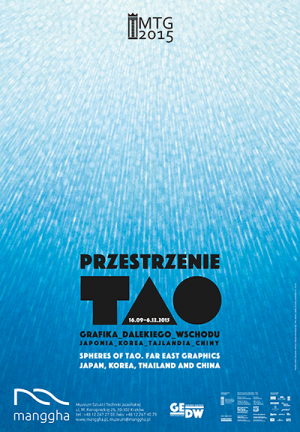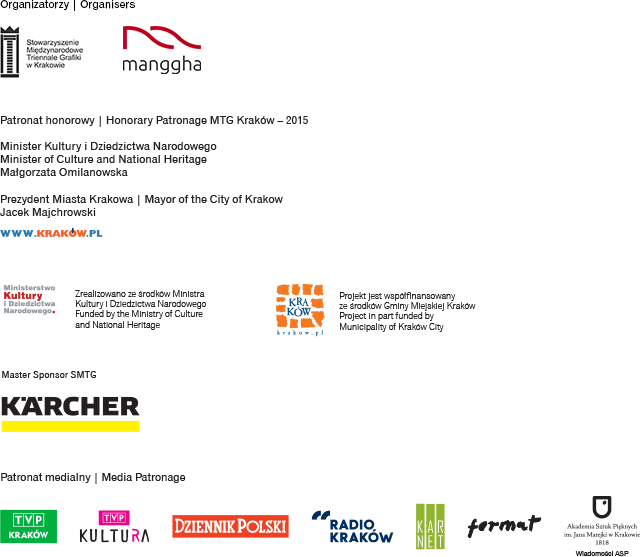Manggha Museum of Japanese Art and Technology – Europe – Far East Gallery
26 M. Konopnickiej, 30-302 Krakow
see the map
17.09.2015 – 06.12.2015
vernissage: 16.09.2015, 19:00

The exhibition The Spheres of Tao shows prints from the Far East – Japan, Korea, Thailand and China – including prize-winning works from the International Print Biennials and Triennials in Kraków. All come from the collection amassed by the International Print Triennial Society over several decades. The show is a retrospective of some personages and developments eminent in printmaking over the last 40 years.
Tao means ‘a way, a path’, and a path also presupposes knowing, cognition. Far Eastern prints are characterised by the closeness and intimacy occasioned by small scale, but also a spiritual dimension and monumentality. The idea of the exhibition is to show both abstract and figurative works in which the problem of space is a significant component. Space, as a void filled with potential possibilities, becomes a space for a game, a multilevel mystery or puzzle. Emotion is combined with mysticism, cool intellect, synthesis and crystallisation of forms. The phenomenon of Far Eastern printmaking is also rooted in the sense of continuous being: being in the tradition, in the language and calligraphy, in the diversity of artistic imagery. The artist’s perspective becomes the perspective for generations.
Japanese printmaking reflects the woodblock tradition and a memory of its prominent artists’ achievements. The technical skill and quality as well as the narrative nature and impeccable beauty of that art are a radiating heritage. So firmly rooted in the past, this printmaking focuses the attention of experimental artists. That was the path set by the first winner of the Grand Prix of the International Print Biennial in Krakow in 1966, Kumi Sugai. In his serigraphs, space clashed with the void, the sign with form, colour with the black-and-white combination. A tremor of forms arises at the point of contact between flat areas. Those are some of the most valuable works in the Triennial Society’s collection.
The recipient of the Kraków Triennial Grand Prix in 1994 and the Grand Prix d’Honneur in 2003, Toshihiro Hamano represents sophisticated skill and monumental works. Memorable through the beauty of forms that show affinity to calligraphy and architecture, these works are pervaded with a mystical light that models shapes, detaches them from reality and transports them into a spiritual dimension. The impossible geometry enchants us with its rhythms while the strong and pronounced form becomes diffused into velvet black.
Toshio Yoshizumi specialises in the drypoint technique. His large-format prints with repetitive motifs of faces/masks and abstract shapes called into existence by wide hand motions overwhelm the viewer with their exuberance of expression. Modest in their monochrome black and restrained in narrative, they suggest rather than tell, engage you and then suddenly discontinue a thought and leave it in suspension.
The characteristic features of Korean printmaking include work with original paper, monumental plates as well as combination of classical and digital techniques. This art is modern through and through, open, communicative. At the same time it carries such a strong cultural message that it is instantly recognisable and emblematic for this part of the Far East. The works in the exhibition represent such trends or styles as organic abstraction, transformed figuration, and a photorealism made unreal by strong contrasts.
Thailand stands for enchantment with the beauty of nature, but also the themes of transience and futility. The works of the two-time prize winner (1994 and 1997), Thavorn Ko-Udomvit represent the peak period of the artist experimenting with two-sided printing, paper translucency, and integrated inclusions of gold and silver foil. The abstract flat form, rich in its structure and its colour layers, is juxtaposed with veristic depictions of objects. The relations that have been set in this way reveal new contexts of things, either fetishising them or depriving them of reality. Although printmaking in their essence, these works verge on painting, with their rich surfaces and sophisticated colour schemes.
China is represented by Poon Man-Lock’s abstract serigraphs, exhibited at the Print Biennial back in 1976. These are some of the oldest works in this exhibition.
The prints are displayed in the modern exhibition space of the Manggha Museum’s Europe–Far East Gallery, where they can shine with their full brilliance. I would like to thank the Manggha Museum of Japanese Art and Technology for this collaboration and am truly glad that, with The Spheres of Tao, we are opening up new perspectives and prospects for the presentation of Far Eastern art in Kraków.
Monika Wanyura-Kurosad
Curator of the exhibition
translation: Jerzy Juruś
artists
JAPONIA
Kumi Sugai, Toshihiro Hamano, Eiko Honda, Junichi Morimoto, Tetsuya Noda, Kaoru Sako, Masahiro Kasai, Masataka Kuroyanagi, Noriko Ogawa, Masahiko Tsubota, Toshio Yoshizumi, Tetsuo Yamashita, Takahiro Aoki
KOREA
Sang-Gon Chung, Tae-Hug Kim, Ja-Hyun Koo, Young Ae Lee, Jeong-Il Hwang
TAJLANDIA
Thavorn Ko-Udomvit, Chalermsak Lattanachun, Vorakorn Metmanorom, Chutchawan Wannapo
CHINY
Man-Lock Poon
HONGKONG
Yip Sun Sun
LAUREATES:
